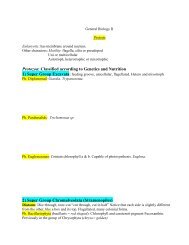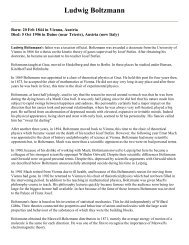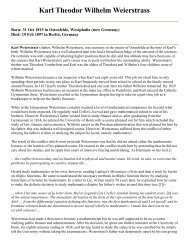Click for Pierre de Fermat biography.
Click for Pierre de Fermat biography.
Click for Pierre de Fermat biography.
Create successful ePaper yourself
Turn your PDF publications into a flip-book with our unique Google optimized e-Paper software.
<strong>Pierre</strong> <strong>de</strong> <strong>Fermat</strong><br />
Born: 17 Aug 1601 in Beaumont-<strong>de</strong>-Lomagne, France<br />
Died: 12 Jan 1665 in Castres, France<br />
<strong>Pierre</strong> <strong>Fermat</strong>'s father was a wealthy leather merchant and second consul of Beaumont- <strong>de</strong>- Lomagne. <strong>Pierre</strong><br />
had a brother and two sisters and was almost certainly brought up in the town of his birth. Although there is<br />
little evi<strong>de</strong>nce concerning his school education it must have been at the local Franciscan monastery.<br />
He atten<strong>de</strong>d the University of Toulouse be<strong>for</strong>e moving to Bor<strong>de</strong>aux in the second half of the 1620s. In<br />
Bor<strong>de</strong>aux he began his first serious mathematical researches and in 1629 he gave a copy of his restoration of<br />
Apollonius's Plane loci to one of the mathematicians there. Certainly in Bor<strong>de</strong>aux he was in contact with<br />
Beaugrand and during this time he produced important work on maxima and minima which he gave to Étienne<br />
d'Espagnet who clearly shared mathematical interests with <strong>Fermat</strong>.<br />
From Bor<strong>de</strong>aux <strong>Fermat</strong> went to Orléans where he studied law at the University. He received a <strong>de</strong>gree in civil<br />
law and he purchased the offices of councillor at the parliament in Toulouse. So by 1631 <strong>Fermat</strong> was a lawyer<br />
and government official in Toulouse and because of the office he now held he became entitled to change his<br />
name from <strong>Pierre</strong> <strong>Fermat</strong> to <strong>Pierre</strong> <strong>de</strong> <strong>Fermat</strong>.<br />
For the remain<strong>de</strong>r of his life he lived in Toulouse but as well as working there he also worked in his home town<br />
of Beaumont-<strong>de</strong>-Lomagne and a nearby town of Castres. From his appointment on 14 May 1631 <strong>Fermat</strong> worked<br />
in the lower chamber of the parliament but on 16 January 1638 he was appointed to a higher chamber, then in<br />
1652 he was promoted to the highest level at the criminal court. Still further promotions seem to indicate a<br />
fairly meteoric rise through the profession but promotion was done mostly on seniority and the plague struck<br />
the region in the early 1650s meaning that many of the ol<strong>de</strong>r men died. <strong>Fermat</strong> himself was struck down by the<br />
plague and in 1653 his <strong>de</strong>ath was wrongly reported, then corrected:-<br />
I in<strong>for</strong>med you earlier of the <strong>de</strong>ath of <strong>Fermat</strong>. He is alive, and we no longer fear <strong>for</strong> his health, even though we<br />
had counted him among the <strong>de</strong>ad a short time ago.<br />
The following report, ma<strong>de</strong> to Colbert the leading figure in France at the time, has a ring of truth:-<br />
<strong>Fermat</strong>, a man of great erudition, has contact with men of learning everywhere. But he is rather preoccupied,<br />
he does not report cases well and is confused.<br />
Of course <strong>Fermat</strong> was preoccupied with mathematics. He kept his mathematical friendship with Beaugrand after<br />
he moved to Toulouse but there he gained a new mathematical friend in Carcavi. <strong>Fermat</strong> met Carcavi in a<br />
professional capacity since both were councillors in Toulouse but they both shared a love of mathematics and<br />
<strong>Fermat</strong> told Carcavi about his mathematical discoveries.<br />
In 1636 Carcavi went to Paris as royal librarian and ma<strong>de</strong> contact with Mersenne and his group. Mersenne's<br />
interest was aroused by Carcavi's <strong>de</strong>scriptions of <strong>Fermat</strong>'s discoveries on falling bodies, and he wrote to <strong>Fermat</strong>.<br />
<strong>Fermat</strong> replied on 26 April 1636 and, in addition to telling Mersenne about errors which he believed that<br />
Galileo had ma<strong>de</strong> in his <strong>de</strong>scription of free fall, he also told Mersenne about his work on spirals and his<br />
restoration of Apollonius's Plane loci. His work on spirals had been motivated by consi<strong>de</strong>ring the path of free<br />
falling bodies and he had used methods generalised from Archime<strong>de</strong>s' work On spirals to compute areas un<strong>de</strong>r<br />
the spirals. In addition <strong>Fermat</strong> wrote:-
I have also found many sorts of analyses <strong>for</strong> diverse problems, numerical as well as geometrical, <strong>for</strong> the<br />
solution of which Viète's analysis could not have sufficed. I will share all of this with you whenever you wish<br />
and do so without any ambition, from which I am more exempt and more distant than any man in the world.<br />
It is somewhat ironical that this initial contact with <strong>Fermat</strong> and the scientific community came through his study<br />
of free fall since <strong>Fermat</strong> had little interest in physical applications of mathematics. Even with his results on free<br />
fall he was much more interested in proving geometrical theorems than in their relation to the real world. This<br />
first letter did however contain two problems on maxima which <strong>Fermat</strong> asked Mersenne to pass on to the Paris<br />
mathematicians and this was to be the typical style of <strong>Fermat</strong>'s letters, he would challenge others to find results<br />
which he had already obtained.<br />
Roberval and Mersenne found that <strong>Fermat</strong>'s problems in this first, and subsequent, letters were extremely<br />
difficult and usually not soluble using current techniques. They asked him to divulge his methods and <strong>Fermat</strong><br />
sent Method <strong>for</strong> <strong>de</strong>termining Maxima and Minima and Tangents to Curved Lines, his restored text of<br />
Apollonius's Plane loci and his algebraic approach to geometry Introduction to Plane and Solid Loci to the<br />
Paris mathematicians.<br />
His reputation as one of the leading mathematicians in the world came quickly but attempts to get his work<br />
published failed mainly because <strong>Fermat</strong> never really wanted to put his work into a polished <strong>for</strong>m. However<br />
some of his methods were published, <strong>for</strong> example Hérigone ad<strong>de</strong>d a supplement containing <strong>Fermat</strong>'s methods of<br />
maxima and minima to his major work Cursus mathematicus. The wi<strong>de</strong>ning correspon<strong>de</strong>nce between <strong>Fermat</strong><br />
and other mathematicians did not find universal praise. Frenicle <strong>de</strong> Bessy became annoyed at <strong>Fermat</strong>'s problems<br />
which to him were impossible. He wrote angrily to <strong>Fermat</strong> but although <strong>Fermat</strong> gave more <strong>de</strong>tails in his reply,<br />
Frenicle <strong>de</strong> Bessy felt that <strong>Fermat</strong> was almost teasing him.<br />
However <strong>Fermat</strong> soon became engaged in a controversy with a more major mathematician than Frenicle <strong>de</strong><br />
Bessy. Having been sent a copy of Descartes' La Dioptrique by Beaugrand, <strong>Fermat</strong> paid it little attention since<br />
he was in the middle of a correspon<strong>de</strong>nce with Roberval and Étienne Pascal over methods of integration and<br />
using them to find centres of gravity. Mersenne asked him to give an opinion on La Dioptrique which <strong>Fermat</strong><br />
did <strong>de</strong>scribing it as<br />
groping about in the shadows.<br />
He claimed that Descartes had not correctly <strong>de</strong>duced his law of refraction since it was inherent in his<br />
assumptions. To say that Descartes was not pleased is an un<strong>de</strong>rstatement. Descartes soon found reason to feel<br />
even more angry since he viewed <strong>Fermat</strong>'s work on maxima, minima and tangents as reducing the importance of<br />
his own work La Géométrie which Descartes was most proud of and which he sought to show that his Discours<br />
<strong>de</strong> la métho<strong>de</strong> alone could give.<br />
Descartes attacked <strong>Fermat</strong>'s method of maxima, minima and tangents. Roberval and Étienne Pascal became<br />
involved in the argument and eventually so did Desargues who Descartes asked to act as a referee. <strong>Fermat</strong><br />
proved correct and eventually Descartes admitted this writing:-<br />
... seeing the last method that you use <strong>for</strong> finding tangents to curved lines, I can reply to it in no other way than<br />
to say that it is very good and that, if you had explained it in this manner at the outset, I would have not<br />
contradicted it at all.<br />
Did this end the matter and increase <strong>Fermat</strong>'s standing? Not at all since Descartes tried to damage <strong>Fermat</strong>'s<br />
reputation. For example, although he wrote to <strong>Fermat</strong> praising his work on <strong>de</strong>termining the tangent to a cycloid<br />
(which is in<strong>de</strong>ed correct), Descartes wrote to Mersenne claiming that it was incorrect and saying that <strong>Fermat</strong><br />
was ina<strong>de</strong>quate as a mathematician and a thinker. Descartes was important and respected and thus was able to<br />
severely damage <strong>Fermat</strong>'s reputation.
The period from 1643 to 1654 was one when <strong>Fermat</strong> was out of touch with his scientific colleagues in Paris.<br />
There are a number of reasons <strong>for</strong> this. Firstly pressure of work kept him from <strong>de</strong>voting so much time to<br />
mathematics. Secondly the Fron<strong>de</strong>, a civil war in France, took place and from 1648 Toulouse was greatly<br />
affected. Finally there was the plague of 1651 which must have had great consequences both on life in Toulouse<br />
and of course its near fatal consequences on <strong>Fermat</strong> himself. However it was during this time that <strong>Fermat</strong><br />
worked on number theory.<br />
<strong>Fermat</strong> is best remembered <strong>for</strong> this work in number theory, in particular <strong>for</strong> <strong>Fermat</strong>'s Last Theorem. This<br />
theorem states that<br />
x n + y n = z n<br />
has no non-zero integer solutions <strong>for</strong> x, y and z when n > 2. <strong>Fermat</strong> wrote, in the margin of Bachet's translation<br />
of Diophantus's Arithmetica<br />
I have discovered a truly remarkable proof which this margin is too small to contain.<br />
These marginal notes only became known after <strong>Fermat</strong>'s son Samuel published an edition of Bachet's translation<br />
of Diophantus's Arithmetica with his father's notes in 1670.<br />
It is now believed that <strong>Fermat</strong>'s 'proof' was wrong although it is impossible to be completely certain. The truth<br />
of <strong>Fermat</strong>'s assertion was proved in June 1993 by the British mathematician Andrew Wiles, but Wiles withdrew<br />
the claim to have a proof when problems emerged later in 1993. In November 1994 Wiles again claimed to have<br />
a correct proof which has now been accepted.<br />
Unsuccessful attempts to prove the theorem over a 300 year period led to the discovery of commutative ring<br />
theory and a wealth of other mathematical discoveries.<br />
<strong>Fermat</strong>'s correspon<strong>de</strong>nce with the Paris mathematicians restarted in 1654 when Blaise Pascal, Étienne Pascal's<br />
son, wrote to him to ask <strong>for</strong> confirmation about his i<strong>de</strong>as on probability. Blaise Pascal knew of <strong>Fermat</strong> through<br />
his father, who had died three years be<strong>for</strong>e, and was well aware of <strong>Fermat</strong>'s outstanding mathematical abilities.<br />
Their short correspon<strong>de</strong>nce set up the theory of probability and from this they are now regar<strong>de</strong>d as joint<br />
foun<strong>de</strong>rs of the subject. <strong>Fermat</strong> however, feeling his isolation and still wanting to adopt his old style of<br />
challenging mathematicians, tried to change the topic from probability to number theory. Pascal was not<br />
interested but <strong>Fermat</strong>, not realising this, wrote to Carcavi saying:-<br />
I am <strong>de</strong>lighted to have had opinions con<strong>for</strong>ming to those of M Pascal, <strong>for</strong> I have infinite esteem <strong>for</strong> his genius...<br />
the two of you may un<strong>de</strong>rtake that publication, of which I consent to your being the masters, you may clarify or<br />
supplement whatever seems too concise and relieve me of a bur<strong>de</strong>n that my duties prevent me from taking on.<br />
However Pascal was certainly not going to edit <strong>Fermat</strong>'s work and after this flash of <strong>de</strong>sire to have his work<br />
published <strong>Fermat</strong> again gave up the i<strong>de</strong>a. He went further than ever with his challenge problems however:-<br />
Two mathematical problems posed as insoluble to French, English, Dutch and all mathematicians of Europe by<br />
Monsieur <strong>de</strong> <strong>Fermat</strong>, Councillor of the King in the Parliament of Toulouse.<br />
His problems did not prompt too much interest as most mathematicians seemed to think that number theory was<br />
not an important topic. The second of the two problems, namely to find all solutions of Nx 2 + 1 = y 2 <strong>for</strong> N not a<br />
square, was however solved by Wallis and Brouncker and they <strong>de</strong>veloped continued fractions in their solution.<br />
Brouncker produced rational solutions which led to arguments. Frenicle <strong>de</strong> Bessy was perhaps the only<br />
mathematician at that time who was really interested in number theory but he did not have sufficient<br />
mathematical talents to allow him to make a significant contribution.
<strong>Fermat</strong> posed further problems, namely that the sum of two cubes cannot be a cube (a special case of <strong>Fermat</strong>'s<br />
Last Theorem which may indicate that by this time <strong>Fermat</strong> realised that his proof of the general result was<br />
incorrect), that there are exactly two integer solutions of x 2 + 4 = y 3 and that the equation x 2 + 2 = y 3 has only<br />
one integer solution. He posed problems directly to the English. Everyone failed to see that <strong>Fermat</strong> had been<br />
hoping his specific problems would lead them to discover, as he had done, <strong>de</strong>eper theoretical results.<br />
Around this time one of Descartes' stu<strong>de</strong>nts was collecting his correspon<strong>de</strong>nce <strong>for</strong> publication and he turned to<br />
<strong>Fermat</strong> <strong>for</strong> help with the <strong>Fermat</strong> - Descartes correspon<strong>de</strong>nce. This led <strong>Fermat</strong> to look again at the arguments he<br />
had used 20 years be<strong>for</strong>e and he looked again at his objections to Descartes' optics. In particular he had been<br />
unhappy with Descartes' <strong>de</strong>scription of refraction of light and he now settled on a principle which did in fact<br />
yield the sine law of refraction that Snell and Descartes had proposed. However <strong>Fermat</strong> had now <strong>de</strong>duced it<br />
from a fundamental property that he proposed, namely that light always follows the shortest possible path.<br />
<strong>Fermat</strong>'s principle, now one of the most basic properties of optics, did not find favour with mathematicians at<br />
the time.<br />
In 1656 <strong>Fermat</strong> had started a correspon<strong>de</strong>nce with Huygens. This grew out of Huygens interest in probability<br />
and the correspon<strong>de</strong>nce was soon manipulated by <strong>Fermat</strong> onto topics of number theory. This topic did not<br />
interest Huygens but <strong>Fermat</strong> tried hard and in New Account of Discoveries in the Science of Numbers sent to<br />
Huygens via Carcavi in 1659, he revealed more of his methods than he had done to others.<br />
<strong>Fermat</strong> <strong>de</strong>scribed his method of infinite <strong>de</strong>scent and gave an example on how it could be used to prove that<br />
every prime of the <strong>for</strong>m 4k + 1 could be written as the sum of two squares. For suppose some number of the<br />
<strong>for</strong>m 4k + 1 could not be written as the sum of two squares. Then there is a smaller number of the <strong>for</strong>m 4k + 1<br />
which cannot be written as the sum of two squares. Continuing the argument will lead to a contradiction. What<br />
<strong>Fermat</strong> failed to explain in this letter is how the smaller number is constructed from the larger. One assumes that<br />
<strong>Fermat</strong> did know how to make this step but again his failure to disclose the method ma<strong>de</strong> mathematicians lose<br />
interest. It was not until Euler took up these problems that the missing steps were filled in.<br />
<strong>Fermat</strong> is <strong>de</strong>scribed in [9] as<br />
Secretive and taciturn, he did not like to talk about himself and was loath to reveal too much about his thinking.<br />
... His thought, however original or novel, operated within a range of possibilities limited by that [1600 - 1650]<br />
time and that [France] place.<br />
Carl B Boyer, writing in [2], says:-<br />
Recognition of the significance of <strong>Fermat</strong>'s work in analysis was tardy, in part because he adhered to the<br />
system of mathematical symbols <strong>de</strong>vised by François Viète, notations that Descartes' Géométrie had ren<strong>de</strong>red<br />
largely obsolete. The handicap imposed by the awkward notations operated less severely in <strong>Fermat</strong>'s favourite<br />
field of study, the theory of numbers, but here, un<strong>for</strong>tunately, he found no correspon<strong>de</strong>nt to share his<br />
enthusiasm.<br />
Article by: J J O'Connor and E F Robertson<br />
December 1996












![IL PRINCIPE – NICCOLÒ MACHIAVELLI [NA = Norton Anthology ]](https://img.yumpu.com/15277483/1/190x245/il-principe-niccolo-machiavelli-na-norton-anthology-.jpg?quality=85)



